by Sebastian Milczanowski, published Jan 2014
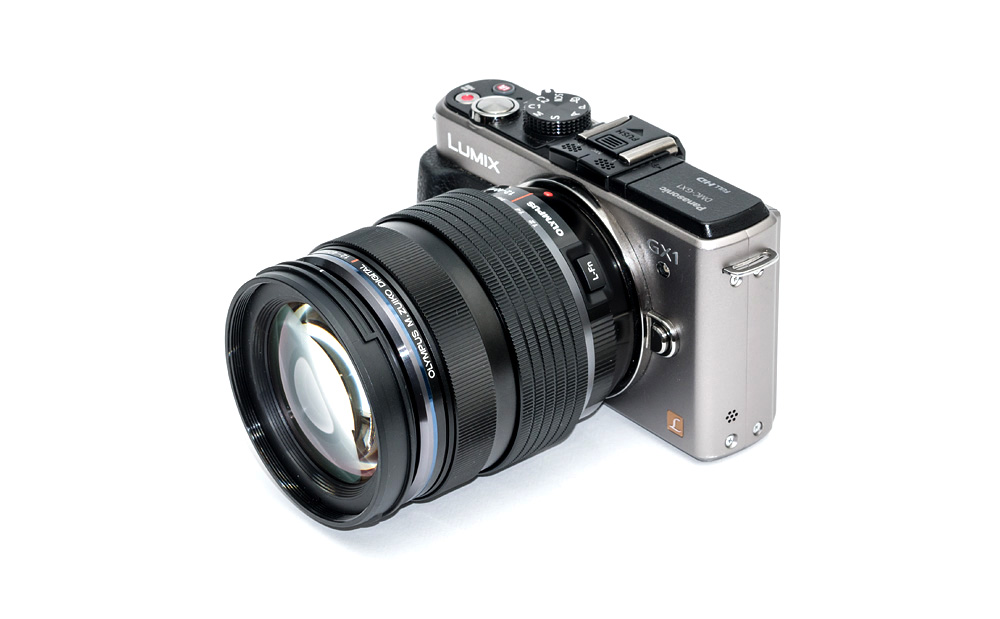
Lens kindly provided by Hendrik Baumgarten.
After five and a half years of Micro-Four-Thirds (MFT) Olympus and Panasonic cover the entire range from 7 to 300mm, including some excellent fixed primes like the Olympus 75mm f/1.8. However, friends of fast zoom lenses were left staring at nothing until the launch of the Panasonic 12-35mm f/2.8 in mid 2012 and only more than one year later Olympus finally joins the league of MFT prime zooms.
Therefore Olympus raises the bar, at least on paper, by spending 5mm extra focal length as well as an outdoors body not only prepared for dusty and rainy but also chilly weather conditions. Anyhow, although the Olympus 12-40mm is an f/2.8-lens in terms of speed, experienced MFT users are aware of the less impressive depth-of-field capabilities due to the sensor size.
Nevertheless, let’s have a closer look at this beauty.
Upon the first contact you will realize that this lens is different comparing to the other MFT lenses as the speed and the weather sealing as well as the pro-finish result in a big and heavy lens. In fact with its 382g it feels too heavy for the Panasonic GX1 with its 320g, but this will be less of a problem for Olympus E-M1 users for sure.
Furthermore, Olympus spend two unique lens features to make photographers and movie enthusiasts’ life easier. On the one hand the manual focus clutch mechanism, which switches easily between auto- and manual focus and on the other hand the L-FN button, which temporarily prevents unwanted autofocus operations in case of accidentally crossing objects. Additionally, you can link this button to an Olympus camera setting.
With other words, the build quality of the lens is excellent and control operations feel adequate for a lens at a price tag of €999.

Olympus is promoting “an unbelievably fast AF high-performance” in combination with the Olympus OM-D and this applies also for our Panasonic cameras. Moreover, talented filmmakers will love the silent autofocus and the focus distance scale.
Finally, the only real downside for Panasonic users might be the missing image stabilisation, which is less of a problem for new Panasonic cameras with integrated image stabilisation like the GX7.
| Specifications | |
|---|---|
| Equiv. focal length | 24-80 mm (full format equivalent) |
| Equiv. aperture | f/5.6 (full format equivalent, in terms of depth-of-field) |
| Optical construction | 14 Elements in 9 Groups (Aspherical ED lens, 2 Aspherical lenses, DSA lens, 2 ED lenses, HD lens, 2 HR lense) |
| Number of aperture blades | 7 (Circular Aperture Diaphragm) |
| min. focus distance | 0.2m (max. magnification 0.3x) |
| Dimensions | 69.9 x 84 mm |
| Weight | 382g |
| Filter size | 62 mm (non-rotating) |
| Hood | Yes |
| Other features | AF-Lock button, manual focus clutch mechanism |
Distortion
Technically distortion is a bit of a weak point of MFT lenses because the system relies on an auto-correction and as such minimizing the issue isn’t really a design priority. You may argue, of course, that this is not relevant from a user perspective because all the applied corrections are done “under the hood”. This is also something that we can confirm – standard JPEGs or conventionally converted RAW files don’t show a significant amount of distortion. At 12mm, there is only a slight degree of barrel distortion (~0.5%) and it’s negligible beyond.
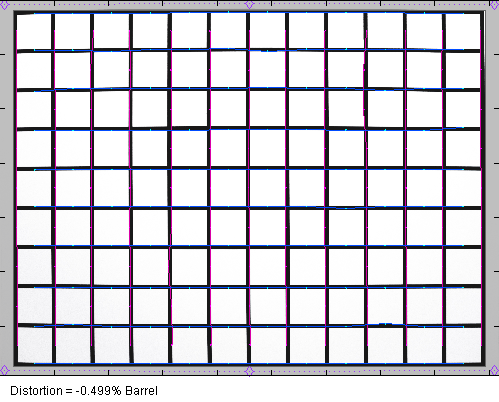

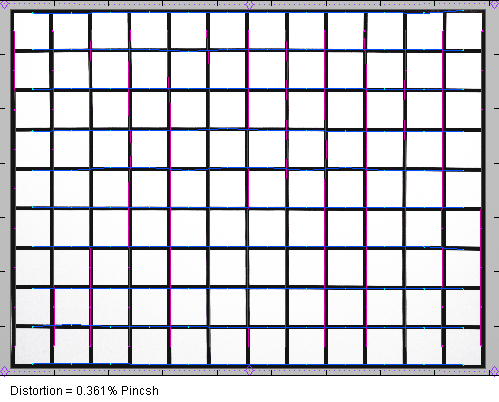
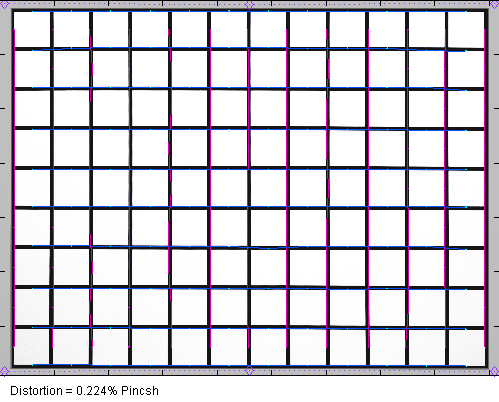
Nevertheless, it is still interesting to look behind the scenes by using an “unsupported” RAW converter. This reveals a native barrel distortion level of disappointing 8.5% at 12mm, which is on the extreme side. However, at 25mm it isn’t overly relevant while the 1% of pincushion distortion at 40mm is a moderate issue.


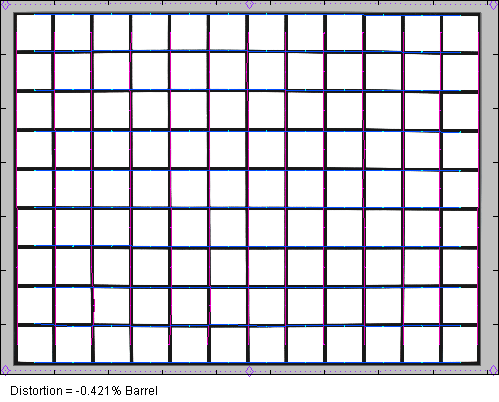
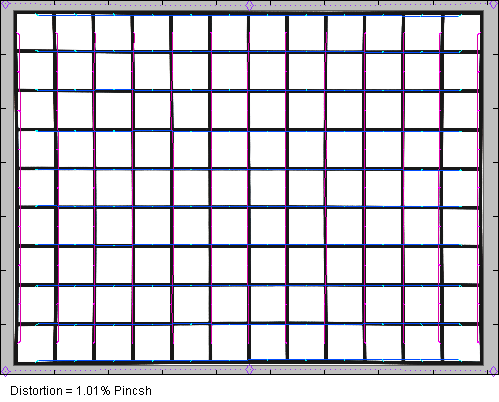
Vignetting
The vignetting characteristic of the lens is pretty disappointing. There’s a high amount of light falloff at 12mm @ f/2.8. and even stopping down reduces this issue only slightly. Fortunately the vignetting gets better beyond 12mm, but its still on a pretty decent level for a “pro” lens.

The next figure illustrates the mentioned vignetting issue at 12mm.
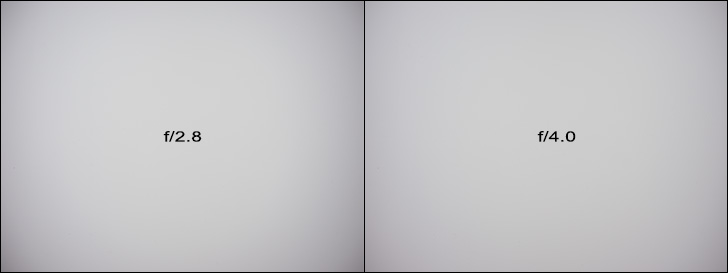
MTF (resolution)
Following the disappointing vignetting results, we proudly present the highest average resolution we tested so far on a MFT zoom lens. The center is incredibly sharp (high contrast + high resolution) trough out the zoom range with only a slight swab at 40mm. The border and corner performance is continuously on a very good level with a very low field curvature so you don’t have to stop down to improve the borders. Please note that the MTF results are not directly comparable across the different systems!
Below is a simplified summary of the formal findings. The chart shows line widths per picture height (LW/PH) which can be taken as a measure of sharpness. If you want to know more about the MTF50 figures you may check out the corresponding Imatest Explanations.
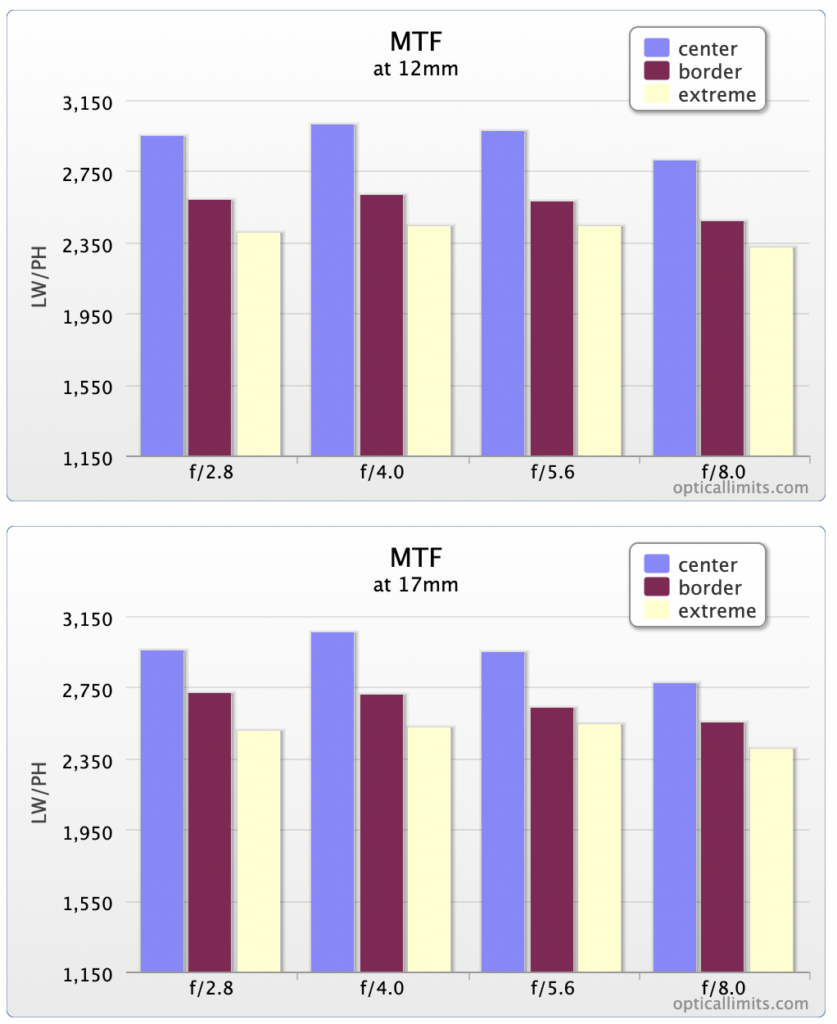
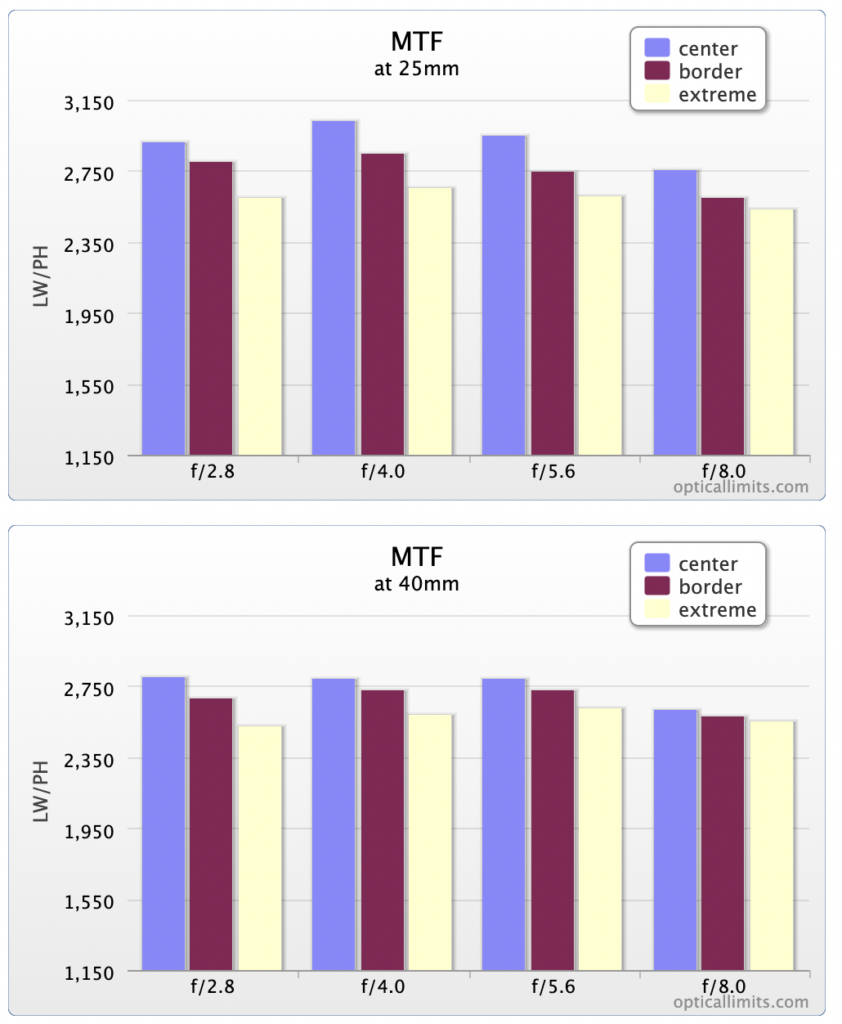
Chromatic Aberrations (CAs)
Lateral CAs (color shadows at the image borders) are also auto-corrected and as CA corrections aren’t lossy we welcome this feature. However, uncorrected RAWs show a different situation and even if the issue isn’t quite as pronounced as on the Panasonic 12-35mm it is still visible with values between 0,7 and 0,8px in average and at 40mm you can even spot some CAs with a pixel width of 1.3px at the image borders.
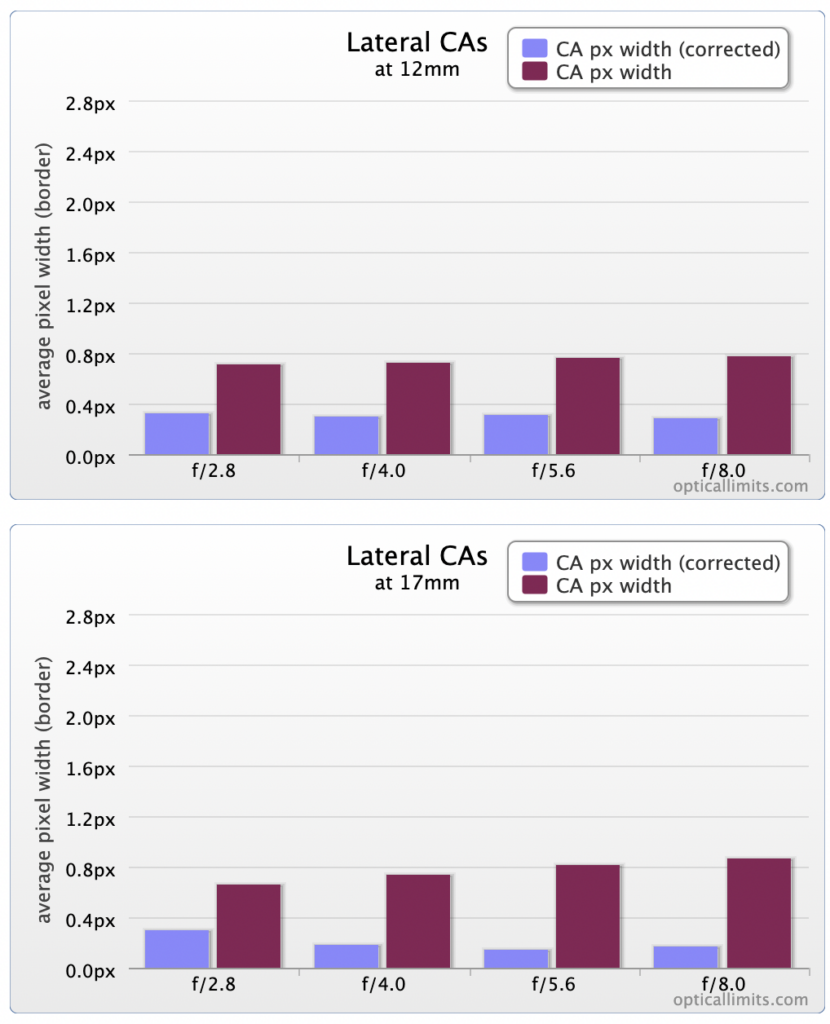
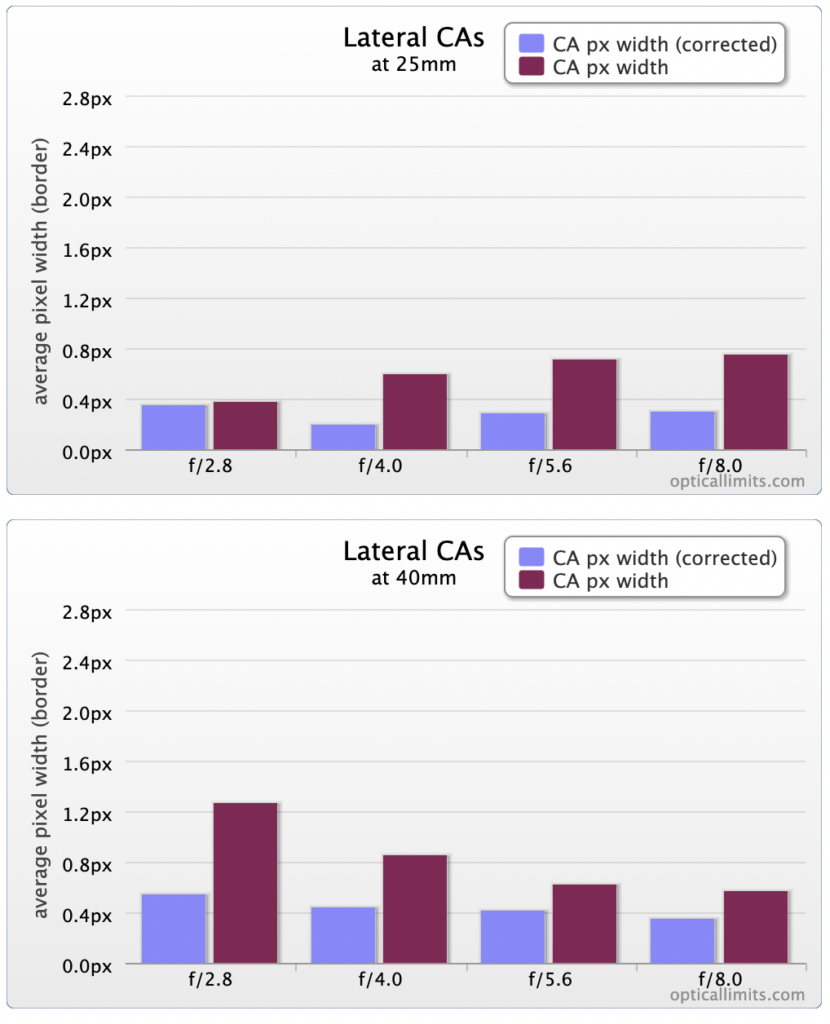
Bokeh
Another important aspect of such prime lenses is the quality of the bokeh (out-of-focus blur) and the Olympus does an acceptable job here. The seven aperture blades deliver a round bokeh at wide-open with smooth transitions delivering a pleasant out-of-focus blur. However, in critical scenes there is a risk of an onion-like substructure and when stopping down out-of-focus highlights show a bit of outlining.

Sample Images
Upon first contact you will immediately fall in love with the Olympus M.ZUIKO DIGITAL ED 12-40mm f/2.8 as the mechanical implementation is exemplary and meets the expectations of a pro lens. Features like the manual focus clutch mechanism or the L-FN button will make photographers likewise movie enthusiasts happy and both will appreciate the fast and silent operation of the autofocus.
The optical quality of this standard zoom is impressive, with an extremely sharp centre zone whereas the border and corner resolution is very good. This perception is once more leveraged by the low amount of lateral CAs. Furthermore the distortion level is fine from a user perspective, but technically it relies on a drastic amount of auto-correction by the system or a RAW-converter - especially at 12mm wide-open.
The quality of the bokeh is not overly impressive but still acceptable for a zoom lens.
Nevertheless, the vignetting results are pretty disappointing and a visible annoyance at 12mm and only slightly better beyond this focal length.
Although Olympus first pro zoom may not be perfect there's much to like about this beautiful lens and while the pricing is a little too steep in our opinion it’s still in line with its direct competitor from Panasonic.
-
Optical Quality
-
Build Quality
-
Price / Performance

